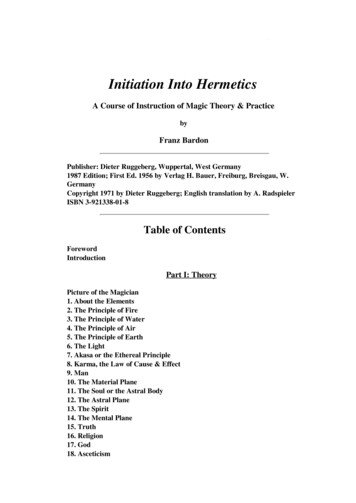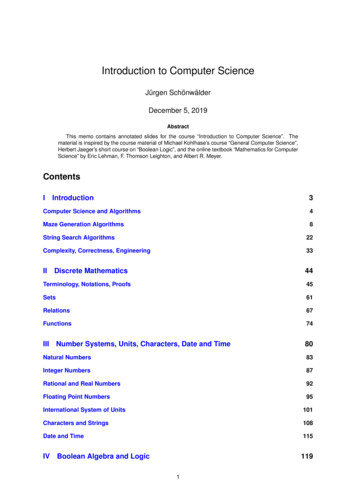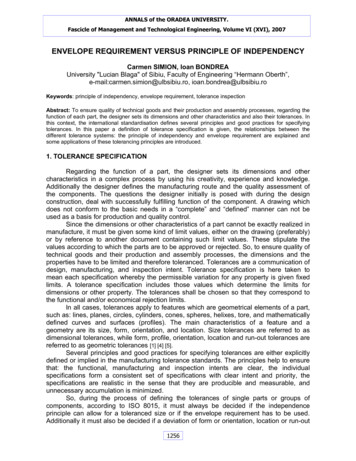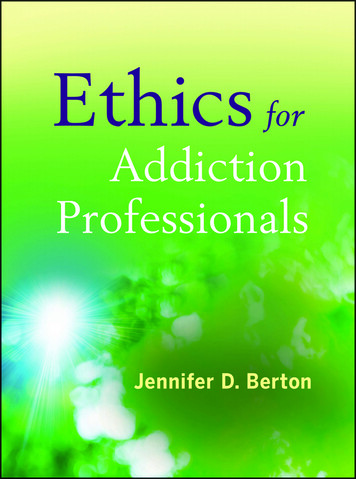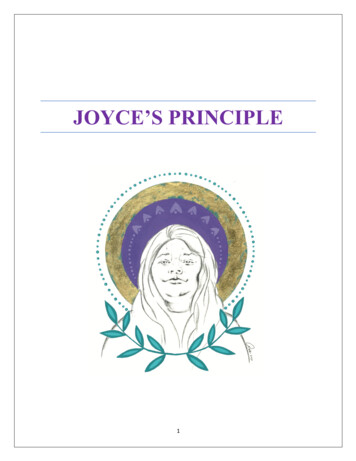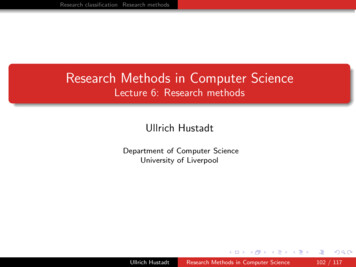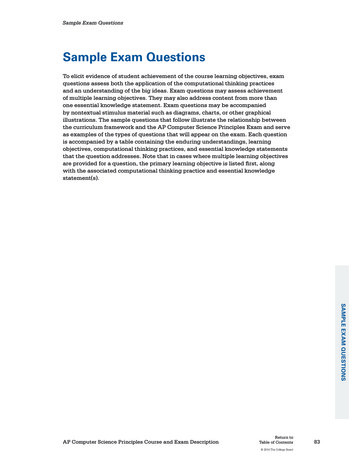
Transcription
Sample Exam QuestionsSample Exam QuestionsTo elicit evidence of student achievement of the course learning objectives, examquestions assess both the application of the computational thinking practicesand an understanding of the big ideas. Exam questions may assess achievementof multiple learning objectives. They may also address content from more thanone essential knowledge statement. Exam questions may be accompaniedby nontextual stimulus material such as diagrams, charts, or other graphicalillustrations. The sample questions that follow illustrate the relationship betweenthe curriculum framework and the AP Computer Science Principles Exam and serveas examples of the types of questions that will appear on the exam. Each questionis accompanied by a table containing the enduring understandings, learningobjectives, computational thinking practices, and essential knowledge statementsthat the question addresses. Note that in cases where multiple learning objectivesare provided for a question, the primary learning objective is listed first, alongwith the associated computational thinking practice and essential knowledgestatement(s).SAMPLE EXAM QUESTIONSAP Computer Science Principles Course and Exam DescriptionReturn toTable of Contents 2014 The College Board83
Sample Exam Questions1. A video-streaming Web site uses 32-bit integers to count the number of times each video hasbeen played. In anticipation of some videos being played more times than can be representedwith 32 bits, the Web site is planning to change to 64-bit integers for the counter. Which of thefollowing best describes the result of using 64-bit integers instead of 32-bit integers?(A) 2 times as many values can be represented.(B) 32 times as many values can be represented.(C) 232 times as many values can be represented.(D) 322 times as many values can be represented.EnduringUnderstandings2.1 A variety ofabstractions built uponbinary sequences canbe used to representall digital data.Learning Objectives2.1.1 Describe the variety ofabstractions used to representdata. [P3]ComputationalThinking PracticesEssentialKnowledgeP3 Abstracting2.1.1A2.1.1B2.1.1E2. A programmer completes the user manual for a video game she has developed and realizes shehas reversed the roles of goats and sheep throughout the text. Consider the programmer’s goalof changing all occurrences of “goats” to “sheep” and all occurrences of “sheep” to “goats.” Theprogrammer will use the fact that the word “foxes” does not appear anywhere in the original text.Which of the following algorithms can be used to accomplish the programmer’s goal?(A) First, change all occurrences of “goats” to “sheep.”Then, change all occurrences of “sheep” to “goats.”SAMPLE EXAM QUESTIONS(B) First, change all occurrences of “goats” to “sheep.”Then, change all occurrences of “sheep” to “goats.”Last, change all occurrences of “foxes” to “sheep.”(C) First, change all occurrences of “goats” to “foxes.”Then, change all occurrences of “sheep” to “goats.”Last, change all occurrences of “foxes” to “sheep.”(D) First, change all occurrences of “goats” to “foxes.”Then, change all occurrences of “foxes” to “sheep.”Last, change all occurrences of “sheep” to “goats.”EnduringUnderstandings4.1 Algorithms areprecise sequencesof instructions forprocesses that can beexecuted by a computerand are implementedusing programminglanguages.Learning ObjectivesComputationalThinking PracticesEssentialKnowledge4.1.1 Develop an algorithm forimplementation in a program. [P2]P2 Creatingcomputational artifacts4.1.1AAP Computer Science Principles Course and Exam Description4.1.1BReturn toTable of Contents 2016 The College Board84
Sample Exam Questions3. ASCII is a character-encoding scheme that uses a numeric value to represent each character.For example, the uppercase letter “G” is represented by the decimal (base 10) value 71. A partiallist of characters and their corresponding ASCII values are shown in the table below.ASCII characters can also be represented by hexadecimal numbers. According to ASCIIcharacter encoding, which of the following letters is represented by the hexadecimal (base 16)number 56?(A) A(B) L(C) V(D) YEnduringUnderstandings2.1.1 Describe the variety ofabstractions used to representdata. [P3]ComputationalThinking PracticesEssentialKnowledgeP3 Abstracting2.1.1A2.1.1CSAMPLE EXAM QUESTIONS2.1 A variety ofabstractions built uponbinary sequences canbe used to representall digital data.Learning Objectives2.1.1D2.1.1E2.1.1GAP Computer Science Principles Course and Exam DescriptionReturn toTable of Contents 2014 The College Board85
Sample Exam Questions4. The figure below shows a circuit composed of two logic gates. The output of the circuit is true.Which of the following is a true statement about input A?(A) Input A must be true.(B) Input A must be false.(C) Input A can be either true or false.(D) There is no possible value of input A that will cause the circuit to have the output true.SAMPLE EXAM QUESTIONSEnduringUnderstandings2.2 Multiple levels ofabstraction are usedto write programsor to create othercomputationalartifacts.Learning Objectives2.2.3 Identify multiple levels ofabstractions being used whenwriting programs. [P3]ComputationalThinking PracticesEssentialKnowledgeP3 Abstracting2.2.3EAP Computer Science Principles Course and Exam Description2.2.3FReturn toTable of Contents 2016 The College Board86
Sample Exam Questions5. The following question uses a robot in a grid of squares. The robot is represented as a triangle,which is initially in the bottom left square of the grid and facing right.Consider the following code segment, which moves the robot in the grid.Which of the following shows the location of the robot after running the code segment?(B)(C)(D)AP Computer Science Principles Course and Exam DescriptionSAMPLE EXAM QUESTIONS(A)Return toTable of Contents 2014 The College Board87
Sample Exam QuestionsEnduringUnderstandings5.2 People writeprograms to executealgorithms.Learning Objectives5.2.1 Explain how programsimplement algorithms. [P3]ComputationalThinking PracticesEssentialKnowledgeP3 Abstracting5.2.1A5.2.1B5.2.1C6. Which of the following statements describes a limitation of using a computer simulation tomodel a real-world object or system?(A) Computer simulations can only be built after the real-world object or system has beencreated.(B) Computer simulations only run on very powerful computers that are not available to thegeneral public.(C) Computer simulations usually make some simplifying assumptions about the real-worldobject or system being modeled.(D) It is difficult to change input parameters or conditions when using computer simulations.EnduringUnderstandings2.3 Models andsimulations useabstraction to generatenew understandingand knowledge.Learning Objectives2.3.1 Use models and simulationsto represent phenomena. [P3]ComputationalThinking PracticesEssentialKnowledgeP3 Abstracting2.3.1A2.3.1C2.3.1DSAMPLE EXAM QUESTIONS7. A certain social media Web site allows users to post messages and to comment on othermessages that have been posted. When a user posts a message, the message itself is considereddata. In addition to the data, the site stores the following metadata.§ The time the message was posted§ The name of the user who posted the message§ The names of any users who comment on the message and the times the comments weremadeAP Computer Science Principles Course and Exam DescriptionReturn toTable of Contents 2016 The College Board88
Sample Exam QuestionsFor which of the following goals would it be more useful to analyze the data instead of themetadata?(A) To determine the users who post messages most frequently(B) To determine the time of day that the site is most active(C) To determine the topics that many users are posting about(D) To determine which posts from a particular user have received the greatest number ofcommentsEnduringUnderstandings3.2 Computingfacilitates explorationand the discoveryof connections ininformation.Learning Objectives3.2.1 Extract information fromdata to discover and explainconnections or trends. [P1]ComputationalThinking PracticesEssentialKnowledgeP1 Connectingcomputing3.2.1B3.2.1G3.2.1H3.2.1I8. The program segment below is intended to move a robot in a grid to a gray square. Theprogram segment uses the procedure GoalReached, which evaluates to true if the robot isin the gray square and evaluates to false otherwise. The robot in each grid is represented asa triangle and is initially facing left. The robot can move into a white or gray square but cannotmove into a black region.AP Computer Science Principles Course and Exam DescriptionSAMPLE EXAM QUESTIONSREPEAT UNTIL (GoalReached ()){IF (CAN MOVE (forward)){MOVE FORWARD ()}IF (CAN MOVE (right)){ROTATE RIGHT ()}IF (CAN MOVE (left)){ROTATE LEFT ()}}Return toTable of Contents 2014 The College Board89
Sample Exam QuestionsFor which of the following grids does the program NOT correctly move the robot to the ing Objectives4.2 Algorithms cansolve many, but notall, computationalproblems.4.2.4 Evaluate algorithmsanalytically and empiricallyfor efficiency, correctness, andclarity. [P4]ComputationalThinking PracticesEssentialKnowledgeP4 Analyzing problemsand artifacts4.2.4BSAMPLE EXAM QUESTIONS9. The table below shows the time a computer system takes to complete a specified task on thecustomer data of different-sized companies.TaskSmall Company(approximately100 customers)Medium Company(approximately1,000 customers)Large Company(approximately10,000 customers)Backing up data2 hours20 hours200 hoursDeleting entries fromdata100 hours200 hours300 hoursSearching through data250 hours300 hours350 hoursSorting data0.01 hour1 hour100 hoursAP Computer Science Principles Course and Exam DescriptionReturn toTable of Contents 2016 The College Board90
Sample Exam QuestionsBased on the information in the table, which of the following tasks is likely to take the longestamount of time when scaled up for a very large company of approximately 100,000 customers?(A) Backing up data(B) Deleting entries from data(C) Searching through data(D) Sorting dataEnduringUnderstandingsLearning Objectives3.2 Computingfacilitates explorationand the discoveryof connections ininformation.3.2.2 Determine how largedata sets impact the use ofcomputational processesto discover informationand knowledge. [P3]ComputationalThinking PracticesEssentialKnowledgeP3 Abstracting3.2.2E3.2.2F3.2.2H10. Consider the code segment below.SAMPLE EXAM QUESTIONSIf the variables onTime and absent both have the value false, what is displayed as a result ofrunning the code segment?(A) Is anyone there?(B) Better late than never.(C) Hello. Is anyone there?(D) Hello. Better late than never.AP Computer Science Principles Course and Exam DescriptionReturn toTable of Contents 2014 The College Board91
Sample Exam QuestionsEnduringUnderstandings4.1 Algorithms areprecise sequencesof instructions forprocesses that canbe executed bya computer andare implementedusing programminglanguages.Learning ObjectivesComputationalThinking PracticesEssentialKnowledge4.1.1 Develop an algorithm forimplementation in a program. [P2]P2 Creatingcomputational artifacts4.1.1A4.1.1C11. Under which of the following conditions is it most beneficial to use a heuristic approach tosolve a problem?(A) When the problem can be solved in a reasonable time and an approximate solution isacceptable(B) When the problem can be solved in a reasonable time and an exact solution is needed(C) When the problem cannot be solved in a reasonable time and an approximate solution isacceptable(D) When the problem cannot be solved in a reasonable time and an exact solution is neededEnduringUnderstandings4.2 Algorithms cansolve many, but notall, computationalproblems.Learning Objectives4.2.2 Explain the differencebetween solvable and unsolvableproblems in computer science. [P1]ComputationalThinking PracticesEssentialKnowledgeP1 Connectingcomputing4.2.2A4.2.2B4.2.2CSAMPLE EXAM QUESTIONS12. Which of the following are true statements about digital certificates in Web browsers?I. Digital certificates are used to verify the ownership of encrypted keys used in securedcommunication.II. Digital certificates are used to verify that the connection to a Web site is fault tolerant.(A) I only(B) II only(C) I and II(D) Neither I nor IIAP Computer Science Principles Course and Exam DescriptionReturn toTable of Contents 2016 The College Board92
Sample Exam QuestionsEnduringUnderstandings6.3 Cybersecurity is animportant concern forthe Internet and thesystems built on it.Learning Objectives6.3.1 Identify existingcybersecurity concerns andpotential options that addressthese issues with the Internetand the systems built on it. [P1]ComputationalThinking PracticesEssentialKnowledgeP1 Connectingcomputing6.3.1H6.3.1L6.3.1M13. There are 32 students standing in a classroom. Two different algorithms are given for findingthe average height of the students.Algorithm AStep 1: All students stand.Step 2: A randomly selected student writes his or her height on a card and is seated.Step 3: A randomly selected standing student adds his or her height to the value on the card,records the new value on the card, and is seated. The previous value on the card is erased.Step 4: Repeat step 3 until no students remain standing.Step 5: The sum on the card is divided by 32. The result is given to the teacher.Algorithm BStep 1: All students stand.Step 2: Each student is given a card. Each student writes his or her height on the card.Step 3: Standing students form random pairs at the same time. Each pair adds the numberswritten on their cards and writes the result on one student’s card; the other student isseated. The previous value on the card is erased.Step 4: Repeat step 3 until one student remains standing.Step 5: The sum on the last student’s card is divided by 32. The result is given to the teacher.SAMPLE EXAM QUESTIONSWhich of the following statements is true?(A) Algorithm A always calculates the correct average, but Algorithm B does not.(B) Algorithm B always calculates the correct average, but Algorithm A does not.(C) Both Algorithm A and Algorithm B always calculate the correct average.(D) Neither Algorithm A nor Algorithm B calculates the correct average.EnduringUnderstandingsLearning Objectives4.2 Algorithms cansolve many, but notall, computationalproblems.4.2.4 Evaluate algorithmsanalytically and empiricallyfor efficiency, correctness, andclarity. [P4]ComputationalThinking PracticesEssentialKnowledgeP4 Analyzing problemsand artifacts4.2.4CAP Computer Science Principles Course and Exam DescriptionReturn toTable of Contents 2014 The College Board93
Sample Exam Questions14. The figure below shows a robot in a grid of squares. The robot is represented as a triangle,which is initially facing upward. The robot can move into a white or gray square but cannotmove into a black region.Consider the procedure MoveAndTurn below.SAMPLE EXAM QUESTIONSWhich of the following code segments will move the robot to the gray square?(A)(B)(C)(D)AP Computer Science Principles Course and Exam DescriptionReturn toTable of Contents 2016 The College Board94
Sample Exam QuestionsEnduringUnderstandings5.3 Programming isfacilitated by appropriateabstractions.Learning Objectives5.3.1 Use abstraction to managecomplexity in programs. [P3]ComputationalThinking PracticesEssentialKnowledgeP3 Abstracting5.3.1A5.3.1B5.3.1D5.3.1E5.3.1F5.3.1G15. Biologists often attach tracking collars to wild animals. For each animal, the followinggeolocation data is collected at frequent intervals.§ The time§ The date§ The location of the animalWhich of the following questions about a particular animal could NOT be answered using onlythe data collected from the tracking collars?(A) Approximately how many miles did the animal travel in one week?(B) Does the animal travel in groups with other tracked animals?(C) Do the movement patterns of the animal vary according to the weather?(D) In what geographic locations does the animal typically travel?EnduringUnderstandings3.1.1 Find patterns and testhypotheses about digitallyprocessed information to gaininsight and knowledge. [P4]ComputationalThinking PracticesEssentialKnowledgeP4 Analyzing problemsand artifacts3.1.1ESAMPLE EXAM QUESTIONS3.1 People usecomputer programs toprocess informationto gain insightand knowledge.Learning Objectives16. A summer camp offers a morning session and an afternoon session. The list morningListcontains the names of all children attending the morning session, and the list afternoonListcontains the names of all children attending the afternoon session.Only children who attend both sessions eat lunch at the camp. The camp director wants tocreate lunchList, which will contain the names of children attending both sessions.AP Computer Science Principles Course and Exam DescriptionReturn toTable of Contents 2014 The College Board95
Sample Exam QuestionsThe following code segment is intended to create lunchList, which is initially empty. It usesthe procedure IsFound (list, name), which returns true if name is found in listand returns false otherwise.FOR EACH child IN morningList{ MISSING CODE }Which of the following could replace MISSING CODE so that the code segment works asintended?(A) IF (IsFound (afternoonList, child)){APPEND (lunchList, child)}(B) IF (IsFound (lunchList, child)){APPEND (afternoonList, child)}(C) IF (IsFound (morningList, child)){APPEND (lunchList, child)}(D) IF ((IsFound (morningList, child)) OR(IsFound (afternoonList, child))){APPEND (lunchList, child)}SAMPLE EXAM QUESTIONSEnduringUnderstandings5.3 Programmingis facilitatedby appropriateabstractions.Learning Objectives5.3.1 Use abstraction to managecomplexity in programs. [P3]ComputationalThinking PracticesEssentialKnowledgeP3 Abstracting5.3.1GAP Computer Science Principles Course and Exam Description5.3.1K5.3.1LReturn toTable of Contents 2016 The College Board96
Sample Exam Questions17. Consider the following program code.Which of the following best describes the result of running the program code?(A) The number 0 is displayed.(B) The number 6 is displayed.(C) The number 10 is displayed.(D) Nothing is displayed; the program results in an infinite loop.EnduringUnderstandings5.4 Programs aredeveloped, maintained,and used by people fordifferent purposes.Learning ObjectivesComputationalThinking PracticesEssentialKnowledge5.4.1 Evaluate the correctness ofa program. [P4]P4 Analyzing problemsand artifacts5.4.1E5.4.1K5.4.1N18. Which of the following is a true statement about data compression?SAMPLE EXAM QUESTIONS(A) Data compression is only useful for files being transmitted over the Internet.(B) Regardless of the compression technique used, once a data file is compressed, it cannot berestored to its original state.(C) Sending a compressed version of a file ensures that the contents of the file cannot beintercepted by an unauthorized user.(D) There are trade-offs involved in choosing a compression technique for storing andtransmitting data.AP Computer Science Principles Course and Exam DescriptionReturn toTable of Contents 2014 The College Board97
Sample Exam QuestionsEnduringUnderstandingsLearning Objectives3.3 There are trade-offswhen representinginformation asdigital data.3.3.1 Analyze how datarepresentation, storage, security,and transmission of data involvecomputational manipulationof information. [P4]ComputationalThinking PracticesEssentialKnowledgeP4 Analyzing problemsand artifacts3.3.1C3.3.1D3.3.1E19. An office building has two floors. A computer program is used to control an elevator thattravels between the two floors. Physical sensors are used to set the following Boolean variables.VariableonFloor1DescriptiononFloor2set to true if the elevator is stopped on floor 2; otherwise set to falsecallTo1set to true if the elevator is called to floor 1; otherwise set to falsecallTo2set to true if the elevator is called to floor 2; otherwise set to falseset to true if the elevator is stopped on floor 1; otherwise set to falseThe elevator moves when the door is closed and the elevator is called to the floor that it is notcurrently on. Which of the following Boolean expressions can be used in a selection statementto cause the elevator to move?(A) (onFloor1 AND callTo2) AND (onFloor2 AND callTo1)(B) (onFloor1 AND callTo2) OR (onFloor2 AND callTo1)(C) (onFloor1 OR callTo2) AND (onFloor2 OR callTo1)SAMPLE EXAM QUESTIONS(D) (onFloor1 OR callTo2) OR (onFloor2 OR callTo1)EnduringUnderstandingsLearning Objectives5.5 Programminguses mathematicaland logical concepts.5.5.1 Employ appropriatemathematical and logicalconcepts in programming. [P4]ComputationalThinking PracticesEssentialKnowledgeP1 Connectingcomputing5.5.1E5.5.1F5.5.1G20. According to the domain name system (DNS), which of the following is a subdomain of thedomain example.com?(A) about.example.com(B) example.co.uk(C) example.com.org(D) example.orgAP Computer Science Principles Course and Exam DescriptionReturn toTable of Contents 2016 The College Board98
Sample Exam QuestionsEnduringUnderstandingsLearning Objectives6.2 Characteristics ofthe Internet influencethe systems built on it.6.2.1 Explain characteristics ofthe Internet and the systemsbuilt on it. [P5]ComputationalThinking PracticesEssentialKnowledgeP5 Communicating6.2.1B21. Which of the following algorithms require both selection and iteration?Select two answers.(A) An algorithm that, given two integers, displays the greater of the two integers(B) An algorithm that, given a list of integers, displays the number of even integers in the list(C) An algorithm that, given a list of integers, displays only the negative integers in the list(D) An algorithm that, given a list of integers, displays the sum of the integers in the listEnduringUnderstandings4.1 Algorithms areprecise sequencesof instructions forprocesses that canbe executed bya computer andare implementedusing programminglanguages.Learning ObjectivesComputationalThinking PracticesEssentialKnowledge4.1.1 Develop an algorithm forimplementation in a program. [P2]P2 Creatingcomputational artifacts4.1.1A4.1.1C4.1.1DSAMPLE EXAM QUESTIONS22. A teacher uses the following program to adjust student grades on an assignment by adding5 points to each student’s original grade. However, if adding 5 points to a student’s originalgrade causes the grade to exceed 100 points, the student will receive the maximum possiblescore of 100 points. The students’ original grades are stored in the list gradeList, which isindexed from 1 to n.i 1REPEAT n TIMES{ MISSING CODE i i 1}AP Computer Science Principles Course and Exam DescriptionReturn toTable of Contents 2014 The College Board99
Sample Exam QuestionsThe teacher has the following procedures available.Proceduremin (a, b)Explanationmax (a, b)Returns the greater of the two values a and bReturns the lesser of the two values a and bWhich of the following code segments can replace MISSING CODE so that the programworks as intended?Select two answers.(A) gradeList[i] min (gradeList[i] 5, 100)(B) gradeList[i] max (gradeList[i] 5, 100)(C) gradeList[i] gradeList[i] 5IF (gradeList[i] 100){gradeList[i] gradeList[i] - 5}(D) gradeList[i] gradeList[i] 5IF (gradeList[i] 100){gradeList[i] 100}Learning Objectives5.5 Programminguses mathematicaland logical concepts.5.5.1 Employ appropriatemathematical and logicalconcepts in programming. [P1]ComputationalThinking PracticesEssentialKnowledgeP1 Connectingcomputing5.5.1A5.5.1B5.5.1HSAMPLE EXAM QUESTIONSEnduringUnderstandingsAP Computer Science Principles Course and Exam DescriptionReturn toTable of Contents 2016 The College Board100
Sample Exam QuestionsAnswers to Sample Exam Questions1–C12 – A2–C13 – C3–C14 – C4–A15 – C5–A16 – A6–C17 – D7–C18 – D8–D19 – B9–D20 – A10 – B21 – B, C11 – C22 – A, DSAMPLE EXAM QUESTIONSAP Computer Science Principles Course and Exam DescriptionReturn toTable of Contents 2014 The College Board101
with the associated computational thinking practice and essential knowledge statement(s). 84 Return to . using programming languages. 4.1.1 Develop an algorithm for implementation in a program. [P2] P2 Creating computational artifacts 4.1.1A 4.1.1B. AP Computer Science Principles C

